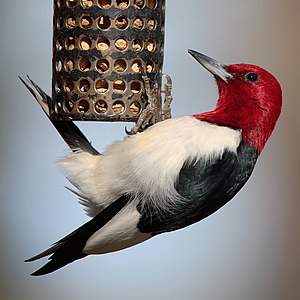 Image via Wikipedia
Image via Wikipedia
Garden Bird Baths - A Refreshing Attraction For Your Local Bird Friends
Ain't nothing like a cool refreshing plunge into a pool on a hot summers day. You know the invigorating feeling you get as you reward yourself with water? Birds like to be rewarded in the same way.
Water is a wonderful way to attract birdies to your neck of the woods and necessary piece of the puzzle when creating a great experience when visiting your yard. Wild birds need drinking water and bathing water and will seek out areas where this supply is constant. There are possibly many birds in your area that may not visit the seed feeders, such as the bluebird who prefer worms and grubs, but will make great use of a bird bath. Bird baths come in all shapes and sizes, heights and weights, decorated and plain. There are garden bird baths out there that will meet the need regardless of your economical situation or decorative preference. The fact of the matter is, a garden bird bath is essential in attracting your local bird friends. Here are some steps to consider when planting a garden bird bath in your yard.
• A bird bath shouldn't be a very deep pool, but a shallow puddle of water. Birds prefer to wade into the water and not just "cannon ball" their way in.
• The edges of your garden bird bath should not be more than a half inch deep and should feature a gradual slope to a maximum depth of about 2 inches. This will also
aide in the wading process. Also make sure that when choosing a bath, the depth of the water's edge is no greater than ½ inch, providing a slope for the birds to walk into like a beach experience. Remember, we don't just want the birds to drink from it, but we want to provide a place for them to bathe.
• The bottom of your bird bath should not be smooth, like a baby's bottom, but rather textured as this provides a good foot grip for the birds when wading in the water. Something slightly rigid or with little bumps will work just fine. Typically your potential smooth bottom bird baths, like copper, come with rigid bottoms, but be sure to find out before purchasing one.
• If you want to allow for more than just a couple birds, consider the diameter and make sure it is anywhere from 20 to 24 inches. Smaller bath's will still be used, especially for drinking. Smaller baths are great for limited space, limited finances or for deck use. For those living in smaller quarters, you can still set up a smaller bath for your local birds to drink and bathe in.
Not only are these garden bird bath's a great attraction for your local feathered friends, but also compliment the care you have put into your yard. Now that we've talked about this, your probably ready to jump in the pool or go and take a cold shower. I know I am. Happy Birding!














![Reblog this post [with Zemanta]](http://img.zemanta.com/reblog_e.png?x-id=aeb42e28-9c40-4bc5-bbf5-2de3fe67a67a)

![Reblog this post [with Zemanta]](http://img.zemanta.com/reblog_e.png?x-id=8eea3cb7-9ddf-4983-a295-6705a2a4b664)